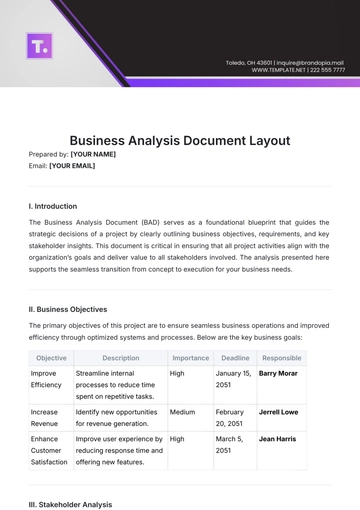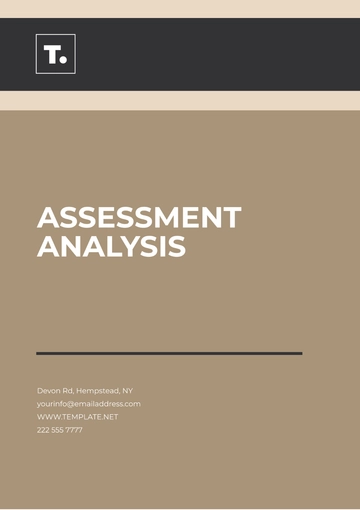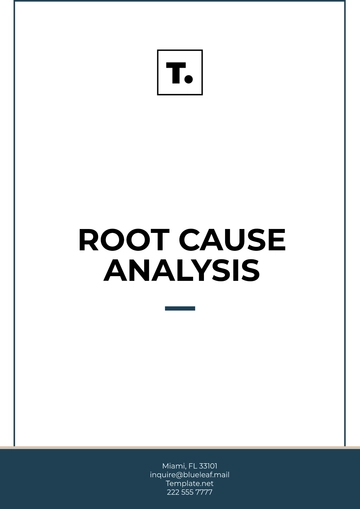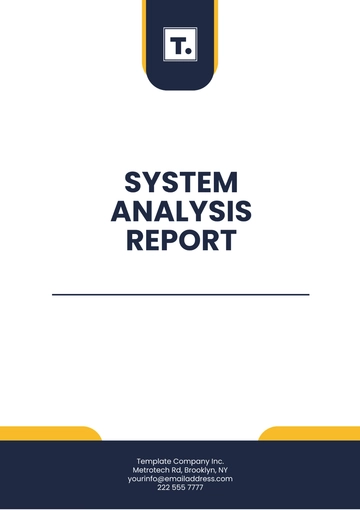Free Real Estate Environmental Impact Analysis
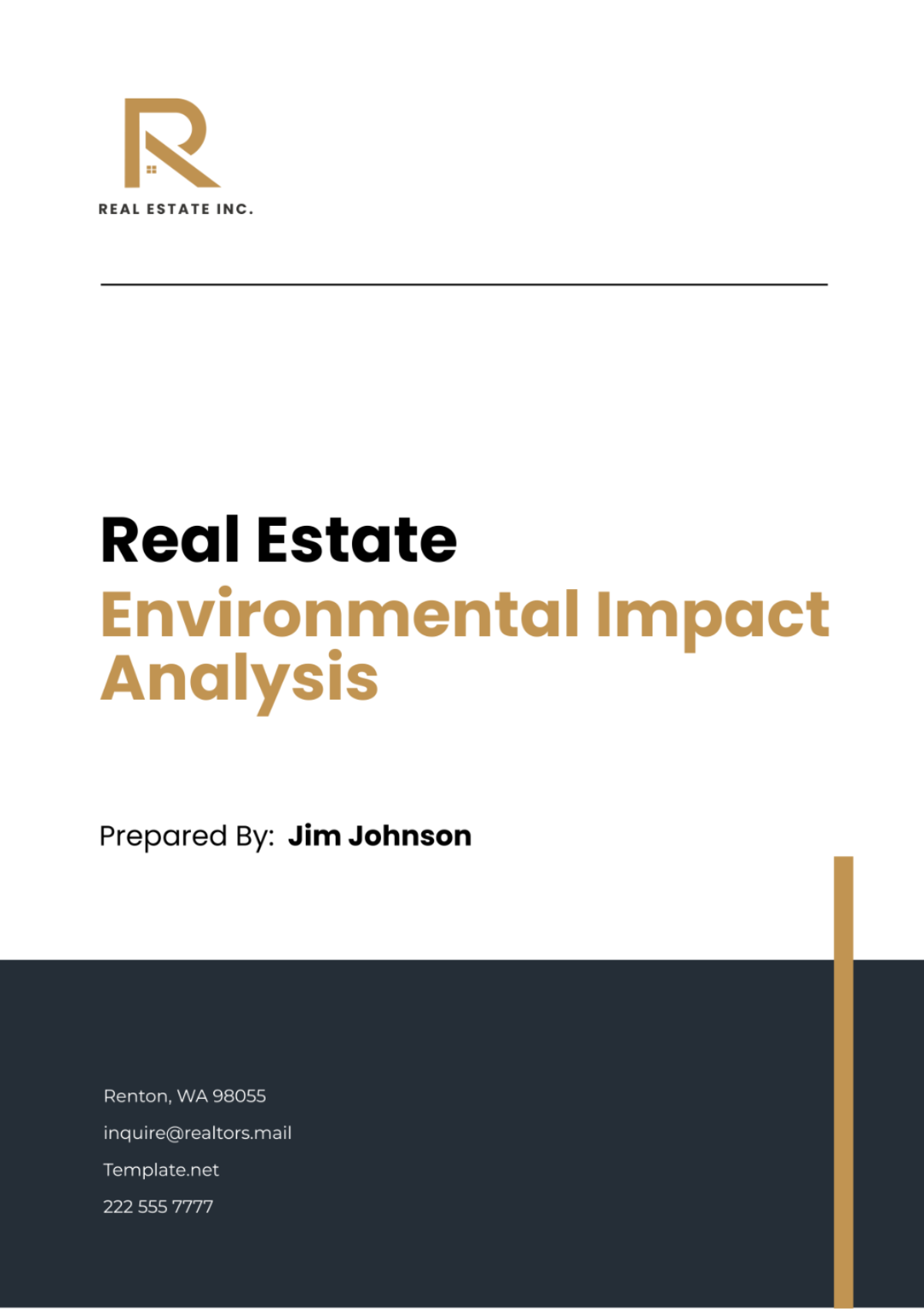
I. Introduction
A. Purpose of the Environmental Impact Analysis
The purpose of this Environmental Impact Analysis (EIA) is to comprehensively assess the potential environmental effects of [Your Company Name]'s upcoming real estate development project. This analysis aims to ensure compliance with regulatory requirements and to promote sustainable development practices that minimize adverse impacts on the environment and surrounding communities.
By conducting this EIA, [Your Company Name] seeks to identify potential environmental risks and opportunities associated with the proposed project, thereby enabling informed decision-making and proactive mitigation strategies.
B. Scope of the Analysis
The scope of this analysis encompasses an evaluation of the environmental impacts associated with [Your Company Name]'s real estate project, which is planned to be situated at [Project Address]. The analysis will consider various environmental factors, including but not limited to air quality, water resources, biodiversity, and land use, to assess both direct and indirect impacts of the project.
This analysis will involve thorough data collection, impact assessment, and mitigation planning to ensure that the project aligns with environmental regulations and sustainability objectives.
II. Methodology
A. Data Collection
In order to facilitate a comprehensive environmental impact assessment, [Your Company Name] will employ a multi-faceted approach to data collection. This will involve gathering information on the physical characteristics of the project site, local environmental conditions, and regulatory requirements.
The data collection process will include:
Site visits to observe and document existing environmental conditions, including topography, soil composition, and vegetation.
Review of relevant environmental studies, reports, and regulatory documents pertaining to the project area.
Consultation with environmental experts and stakeholders to gain insights into potential environmental concerns and mitigation measures.
Additionally, [Your Company Name] will collect data on local climate patterns, air quality parameters, water resources, and biodiversity indicators to inform the impact assessment process.
Data collection methods may include field measurements, remote sensing techniques, and analysis of historical data from government agencies and scientific literature.
B. Impact Assessment
The impact assessment phase will involve the analysis of potential environmental effects associated with the proposed real estate development project. This will include evaluating both short-term and long-term impacts on various environmental receptors, such as air, water, soil, flora, fauna, and human health.
[Your Company Name] will utilize recognized environmental assessment methodologies, predictive modeling tools, and risk assessment techniques to forecast and quantify the magnitude and significance of potential impacts.
The impact assessment will consider direct impacts resulting from project activities (e.g., construction, operation) as well as indirect impacts arising from associated infrastructure development, land use changes, and increased human activity in the area.
Special attention will be given to sensitive receptors and vulnerable populations to ensure that potential adverse impacts are adequately identified and addressed during the mitigation planning process.
The assessment will be conducted in accordance with applicable environmental regulations, industry best practices, and standards established by regulatory agencies and environmental organizations.
III. Environmental Factors
A. Air Quality
The assessment of air quality will focus on evaluating potential emissions of pollutants generated by [Your Company Name]'s real estate project, including particulate matter (PM), nitrogen oxides (NOx), sulfur dioxide (SO2), volatile organic compounds (VOCs), and carbon monoxide (CO). This assessment will consider both construction and operational phases of the project.
Sources of emissions may include construction equipment, on-site transportation, heating and cooling systems, and vehicular traffic associated with the project.
Predictive modeling and dispersion analysis will be utilized to estimate the dispersion and concentration of air pollutants in the vicinity of the project site, taking into account factors such as meteorological conditions, terrain, and emission rates.
Mitigation measures to address air quality impacts may include the use of low-emission construction equipment, implementation of dust control measures, adoption of alternative transportation strategies, and installation of pollution control technologies.
B. Water Resources
The assessment of water resources will evaluate potential impacts on surface water and groundwater quality, as well as hydrological processes such as runoff, infiltration, and recharge. This assessment will consider the project's effects on water quantity, quality, and flow regimes.
Potential sources of water pollution include stormwater runoff, wastewater discharges, chemical spills, and sedimentation from construction activities.
Hydrological modeling and water quality sampling will be conducted to assess the potential for pollutant loading, habitat degradation, and water supply impacts.
Mitigation measures to protect water resources may include the implementation of erosion and sediment control measures, installation of storm water management facilities, adoption of green infrastructure practices, and utilization of water-efficient technologies.
C. Biodiversity
The assessment of biodiversity will focus on identifying sensitive habitats, rare species, and ecological communities within and adjacent to the project site. This assessment will evaluate potential impacts on biodiversity resulting from habitat loss, fragmentation, and degradation.
Habitat mapping, ecological surveys, and species inventories will be conducted to characterize the biodiversity value of the project area and assess potential impacts on flora and fauna.
The assessment will consider both direct impacts (e.g., habitat destruction, species displacement) and indirect impacts (e.g., noise disturbance, light pollution) on biodiversity.
Mitigation measures to conserve biodiversity may include the establishment of protected areas, implementation of habitat restoration and enhancement projects, creation of wildlife corridors, and integration of green space into project design.
D. Land Use
The assessment of land use will examine changes in land cover, land use patterns, and land use intensity resulting from [Your Company Name]'s real estate project. This assessment will consider the conversion of natural and agricultural land to urban uses, as well as the potential for conflicts with existing land uses.
GIS analysis, land use mapping, and land suitability analysis will be utilized to identify areas of high ecological value, cultural significance, and development potential.
The assessment will evaluate the compatibility of the project with local zoning regulations, land use plans, and environmental protection policies.
Mitigation measures to minimize land use impacts may include compact urban design, preservation of open space and green belts, adaptive reuse of existing infrastructure, and integration of mixed-use development principles.
IV. Mitigation Measures
A. Air Quality Mitigation
To mitigate air quality impacts, [Your Company Name] will implement a range of measures aimed at reducing emissions of air pollutants and minimizing exposure to sensitive receptors.
Table 1 provides an overview of proposed air quality mitigation measures:
Mitigation Measure | Description |
|---|---|
Use of low-emission equipment | Replacement of diesel-powered equipment with electric or hybrid alternatives. |
Dust control measures | Application of water or chemical suppressants to minimize dust emissions from construction activities. |
Alternative transportation strategies | Promotion of carpooling, public transit, and alternative modes of transportation for construction workers and employees. |
Pollution control technologies | Installation of air scrubbers, filters, and other pollution control devices on stationary sources. |
B. Water Resources Management
[Your Company Name] will implement various measures to manage water resources and mitigate potential impacts on water quantity and quality.
Table 2 outlines proposed water resources management measures:
Mitigation Measure | Description |
|---|---|
Erosion and sediment control measures | Installation of silt fences, sediment basins, and erosion control blankets to prevent soil erosion and sedimentation during construction activities. |
Storm water management facilities | Construction of retention ponds, infiltration basins, and vegetated swales to capture and treat storm water runoff before discharge. |
Green infrastructure practices | Implementation of permeable pavements, green roofs, and rain gardens to enhance storm water infiltration and reduce runoff volume. |
Water-efficient technologies | Installation of water-saving fixtures, irrigation systems, and landscaping practices to minimize water consumption and runoff. |
V. Conclusion
A. Summary of Findings
The environmental impact analysis conducted for [Your Company Name]'s real estate project has identified various potential impacts on air quality, water resources, biodiversity, and land use.
Key findings from each environmental factor include:
Air Quality:
During the construction phase, significant emissions of particulate matter (PM) and nitrogen oxides (NOx) are anticipated due to heavy machinery and construction activities.
Operational emissions from vehicle traffic within and around the project area may contribute to localized air pollution, especially during peak hours.
Water Resources:
Storm water runoff from the project site has the potential to carry sediment, chemicals, and other pollutants into nearby water bodies, affecting water quality and aquatic habitats.
Groundwater resources may be at risk of contamination from construction-related activities, such as excavation and material storage.
Biodiversity:
The project area contains valuable habitat for several species of native flora and fauna, including migratory birds and small mammals.
Habitat fragmentation resulting from development could disrupt ecological connectivity and negatively impact species' ability to migrate and forage.
Land Use:
Conversion of undeveloped land to urban uses may lead to loss of wildlife habitat, reduction in green spaces, and increased impervious surfaces, affecting local ecosystems and biodiversity.
Changes in land use patterns could also influence microclimate conditions, urban heat island effects, and overall landscape aesthetics.
B. Recommendations
Based on the findings of the analysis, [Your Company Name] recommends the following actions to minimize environmental impacts and promote sustainability:
Implementation of the proposed mitigation measures outlined in the analysis report to address identified environmental concerns.
Continued monitoring and adaptive management of environmental performance throughout the project lifecycle.
Collaboration with stakeholders, regulatory agencies, and community members to ensure transparency and accountability in environmental management efforts.
C. Conclusion
[Your Company Name] remains committed to upholding environmental stewardship principles and integrating sustainable practices into its real estate development projects. By proactively addressing environmental concerns and prioritizing conservation efforts, [Your Company Name] strives to create projects that not only enhance quality of life for residents and stakeholders but also contribute to the long-term health and resilience of the surrounding ecosystem.
VI. Appendices
A. Glossary of Terms
Air Quality Index (AQI): A numerical scale used to communicate the level of air pollution and associated health risks to the public.
Biodiversity: The variety of life forms, including species diversity, genetic diversity, and ecosystem diversity, within a given area.
Erosion: The process by which soil and rock are removed from the Earth's surface by natural forces such as water, wind, and ice.
Green Infrastructure: Natural or engineered systems that mimic the functions of natural ecosystems to manage storm water, reduce urban heat island effects, and enhance biodiversity.
Mitigation Measures: Actions taken to reduce or prevent adverse environmental impacts associated with human activities.
Storm water Runoff: Excess rainwater or melted snow that flows over the land surface and is not absorbed into the soil, often carrying pollutants and sediment into water bodies.
- 100% Customizable, free editor
- Access 1 Million+ Templates, photo’s & graphics
- Download or share as a template
- Click and replace photos, graphics, text, backgrounds
- Resize, crop, AI write & more
- Access advanced editor
Assess environmental impacts effectively with the Real Estate Environmental Impact Analysis Template from Template.net. This editable and customizable template simplifies the analysis process, identifying potential environmental effects of real estate projects. Tailor it effortlessly using our Ai Editor Tool for personalized assessments. Enhance sustainability practices and ensure regulatory compliance with this comprehensive template.




